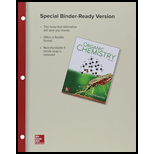
Concept explainers
Consider the following reaction:
a. Use curved arrows to show the movement of electrons.
b. Calculate
c. Draw an energy diagram assuming that
d. What is
Trending nowThis is a popular solution!

Chapter 6 Solutions
Loose Leaf for Organic Chemistry
Additional Science Textbook Solutions
Chemistry: An Introduction to General, Organic, and Biological Chemistry (12th Edition) - Standalone book
Chemistry: A Molecular Approach (4th Edition)
Chemistry & Chemical Reactivity
Chemistry
Chemistry: Structure and Properties
Thermodynamics, Statistical Thermodynamics, & Kinetics
- Draw Lewis electron dot structures for CH3Cl (methyl chloride, a topical anesthetic), H2O2 (hydrogen peroxide, with an O-O bond), and NH2OH (with an N-O bond).arrow_forwardUsing the BDE values from Appendix 3, calculate the Hrxn0 value and state if the reaction below is exothermic or endothermic. CH2=CH2 + HCl CH3CH2Clarrow_forwardCalculate the enthalpy change when 1.0(1 g of methane is burned in excess oxygen according to the reaction CH,(g) 4- 2O2(g) ->CO2(g) + H-CH/) 1H = -891 kJ/molarrow_forward
- Given each of the following values, is the starting material or product lower in energy? a. ΔGo = 8.0 kJ/mol b.Keq = 10 c. ΔGo = −12 kJ/mol d.Keq = 10−3arrow_forwardHh.115.arrow_forwardThe curved arrow notation introduced in Section 1.6 is a powerful method used by organic chemists to show the movement of electrons not only in resonance structures, but also in chemical reactions. Since each curved arrow shows the movement of two electrons, following the curved arrows illustrates what bonds are broken and formed in a reaction. Consider the following three-step process. (a) Add curved arrows in Step [1] to show the movement of electrons. (b) Use the curved arrows drawn in Step [2] to identify the structure of X. X is converted in Step [3] to phenol and HCl.arrow_forward
- The reaction between methanol and hydrochloric acid yields chloromethane and water. What is the enthalpy for the reaction using the given bond energies (kJ mol-1)? C-Cl = 326 H-O = 463 H-Cl = 431 C-O = 335 -511 kJ mol-1 -59 kJ mol-1 -23 kJ mol-1 -42 kJ mol-1 The reaction between methanol and hydrochloric acid yields chloromethane and water. What is the enthalpy for the reaction using the given bond energies (kJ mol-1)? C-Cl = 326 H-O = 463 H-Cl = 431 C-O = 335 -511 kJ mol-1 -59 kJ mol-1 -23 kJ mol-1 -42 kJ mol-1arrow_forward1. A class organic compounds containing a six-membered ring with alternating double bonds that results in delocalization of the electrons within the ring. This class of compounds can have additional groups attached to the ring. 2. A family of organic compounds that can be represented by the general formula R-CHO. 3. A compound with the general formula R-COOH. It is a weak electrolyte that can lose an H+ ion in water solutions. 4. A hydrocarbon with a general formula of CnH(2n+2). All carbon-to-carbon bonds would be single bonds.arrow_forwardWhat is the likelihood that hydrogen (H2) will become a widely used fuel and that the hydrogen economy will become a reality? In particular, what are the advantages and disadvantages of H2 as a fuel? What would be necessary for a significant conversion to a hydrogen economy?arrow_forward
- hat is meant by the term driving forces? Why are mailer spread and energy spread considered to be driving forces?arrow_forwardUsing bond dissociation energies predict the energy given off in the following reaction: C2H4 + O2 → CO2 + H2O A 444 kJ B 634 kJ C 246 kJ D 906 kJarrow_forwardThe compound para-dichlorobenzene is the active ingredient of the bathroom deodorizer "Albatross". How many distinct products are possible for the reaction of para-dichlorobenzene with 1 equivalent of HNO3 in H2SO4? a. 3 b. 2 c. 1 d. 4 e. 5arrow_forward
 Organic ChemistryChemistryISBN:9781305580350Author:William H. Brown, Brent L. Iverson, Eric Anslyn, Christopher S. FootePublisher:Cengage Learning
Organic ChemistryChemistryISBN:9781305580350Author:William H. Brown, Brent L. Iverson, Eric Anslyn, Christopher S. FootePublisher:Cengage Learning Introductory Chemistry: A FoundationChemistryISBN:9781337399425Author:Steven S. Zumdahl, Donald J. DeCostePublisher:Cengage Learning
Introductory Chemistry: A FoundationChemistryISBN:9781337399425Author:Steven S. Zumdahl, Donald J. DeCostePublisher:Cengage Learning Chemistry & Chemical ReactivityChemistryISBN:9781133949640Author:John C. Kotz, Paul M. Treichel, John Townsend, David TreichelPublisher:Cengage Learning
Chemistry & Chemical ReactivityChemistryISBN:9781133949640Author:John C. Kotz, Paul M. Treichel, John Townsend, David TreichelPublisher:Cengage Learning Chemistry & Chemical ReactivityChemistryISBN:9781337399074Author:John C. Kotz, Paul M. Treichel, John Townsend, David TreichelPublisher:Cengage Learning
Chemistry & Chemical ReactivityChemistryISBN:9781337399074Author:John C. Kotz, Paul M. Treichel, John Townsend, David TreichelPublisher:Cengage Learning Chemistry: Principles and PracticeChemistryISBN:9780534420123Author:Daniel L. Reger, Scott R. Goode, David W. Ball, Edward MercerPublisher:Cengage Learning
Chemistry: Principles and PracticeChemistryISBN:9780534420123Author:Daniel L. Reger, Scott R. Goode, David W. Ball, Edward MercerPublisher:Cengage Learning Introductory Chemistry: A FoundationChemistryISBN:9781285199030Author:Steven S. Zumdahl, Donald J. DeCostePublisher:Cengage Learning
Introductory Chemistry: A FoundationChemistryISBN:9781285199030Author:Steven S. Zumdahl, Donald J. DeCostePublisher:Cengage Learning





